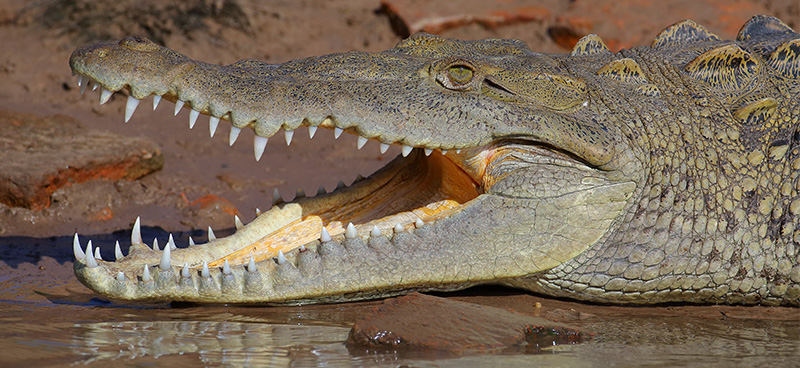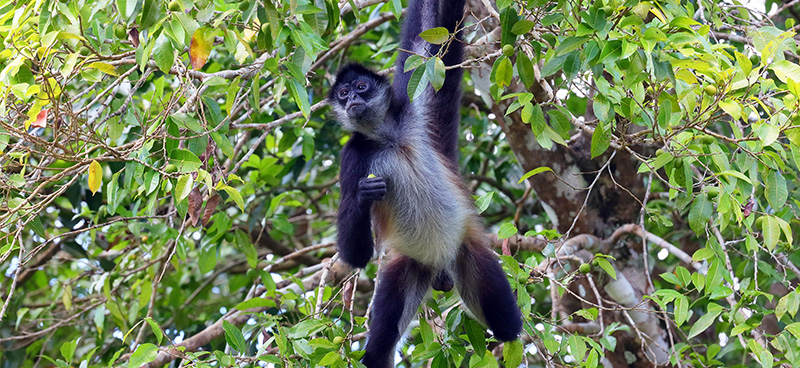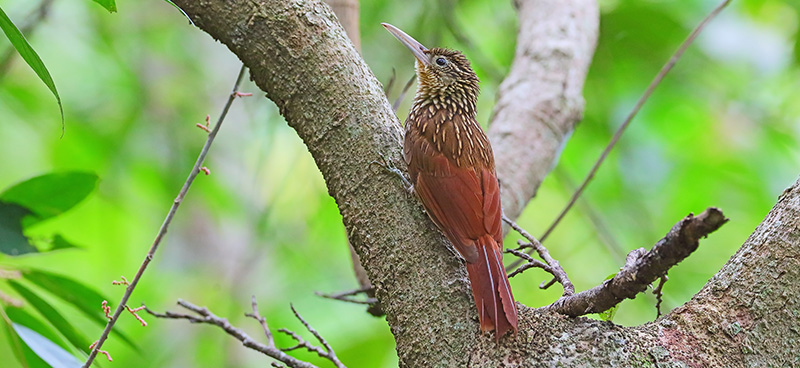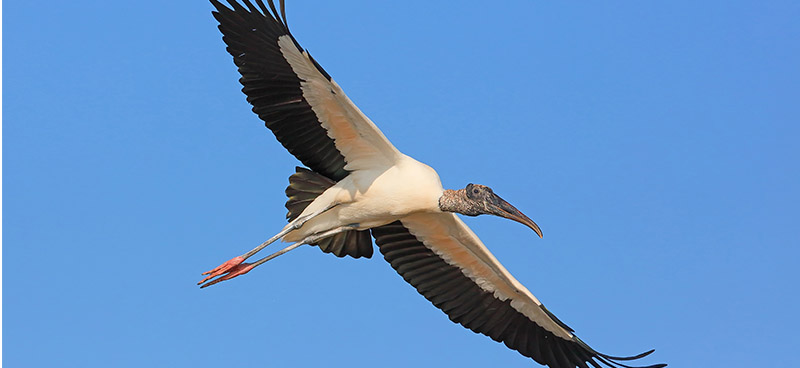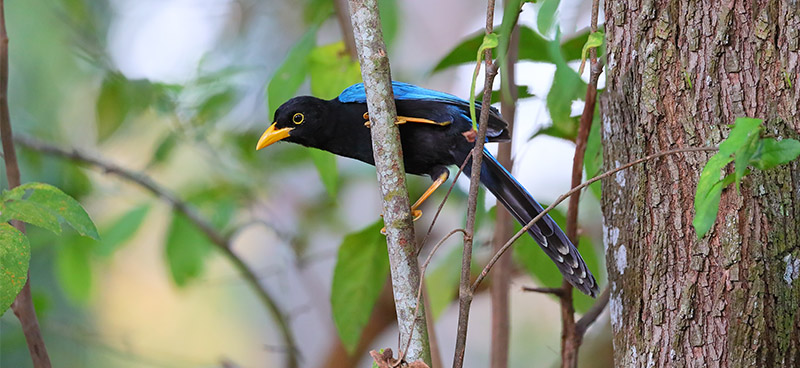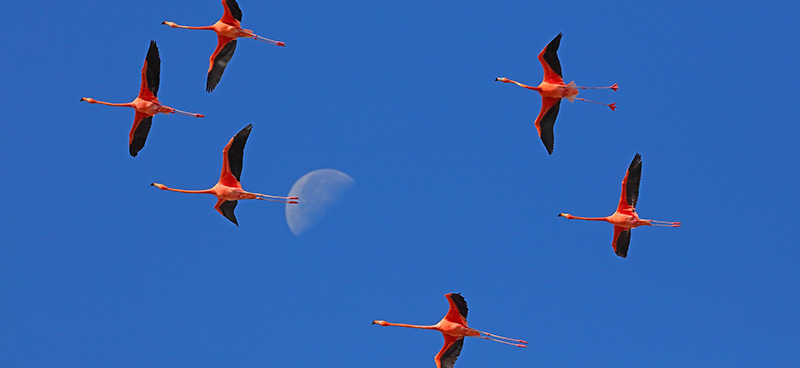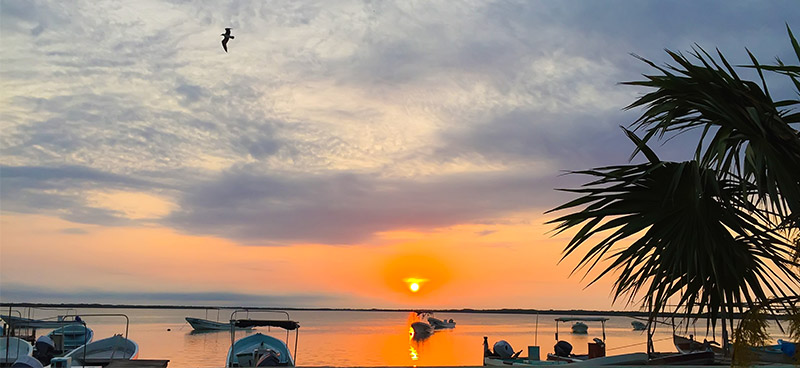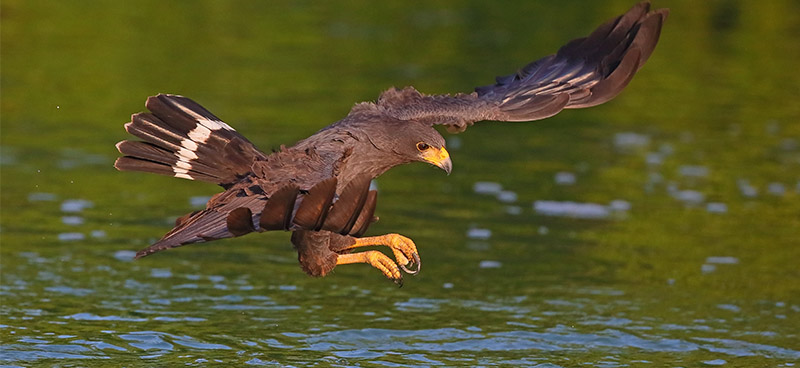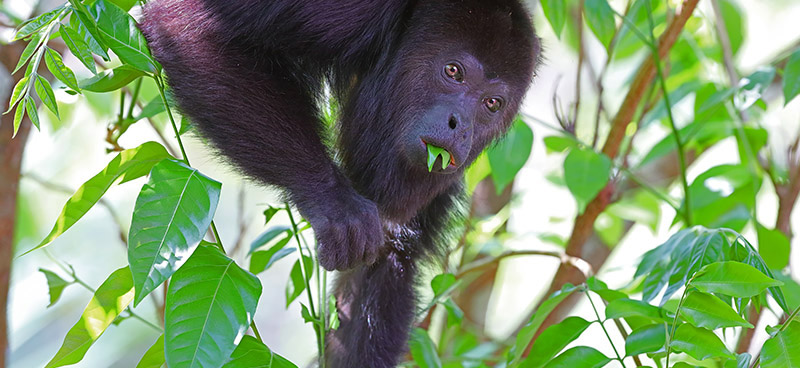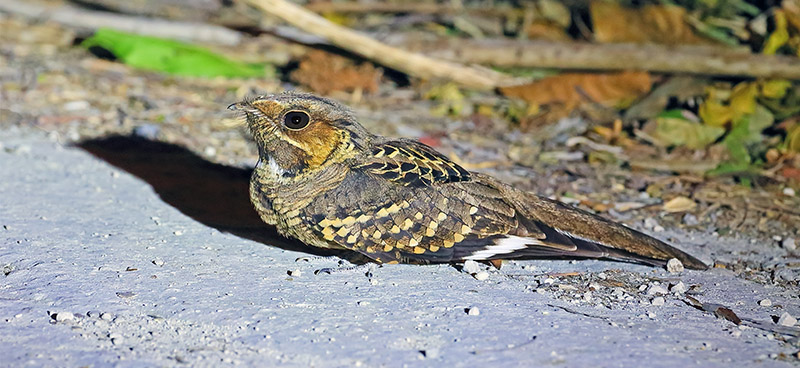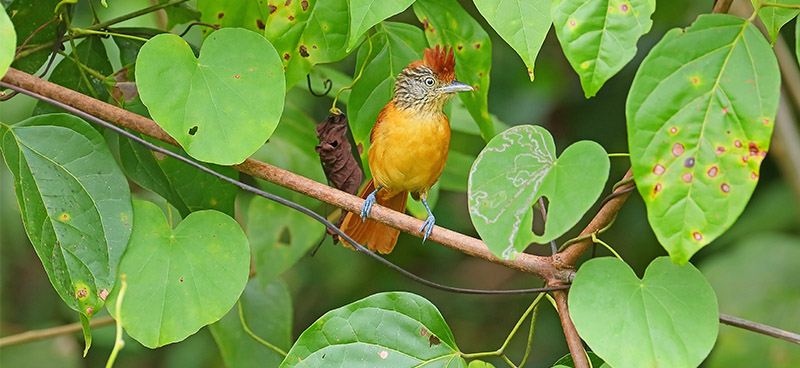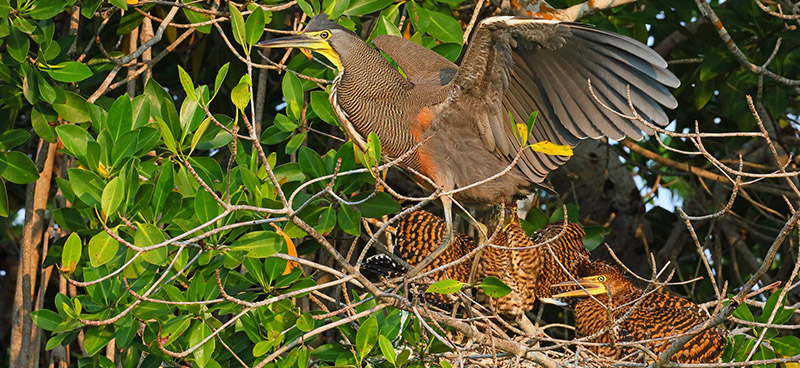EXPEDITION HIGHLIGHTS
Scheduled Dates: 18th-24th January 2018
PART 1: COZUMEL ISLAND, QUINTANA ROO, THE MAYAN RIVIERA & MEXICO’S CARIBBEAN COAST:
*Two days enjoying and exploring Cozumel Island Birding, Archaeological Sites and Nightlife on the Malecon, Quintana Roo State
*Encounter Isla Cozumel’s very special and little-known and seldom-seen endemics—COZUMEL EMERALD, WREN & VIREO—during our visits to San Gervasio & El Cedral Mayan Archaeological Sites; Bello Caribe; Passion Mangrove Biome Observation Tower; Laguna Columbia & the Punta Sur wilderness at the south end of the island, and more
*Two days at UNESCO’s Sian Ka’an Biosphere Reserve to enjoy an overland safari within the interior of the reserve & Boating expedition to see wild WEST INDIAN MANATEES in a beautiful, calm, mangrove-lined lagoon
*Inspiring forests surrounding ancient Mayan ruins at Coba (Late Classic Period—AD 600-900), Quintana Roo State
*Explore the hidden world of the TURQUOISE-BROWED MOTMOT & RIDGEWAY’S ROUGH-WINGED SWALLOW—underground cenotes at Coba Lakes—a unique–and revealing experience!
PART II—YUCATAN STATE, THE GULF OF MEXICO & NORTH YUCATAN PENINSULA:
*Two days at colloquial, friendly Rio Lagartos, where you will marvel at one of the world’s largest colonies of AMERICAN FLAMINGOS—up to 45,000 strong—by boat at Rio Lagartos National Park & Biosphere Reserve, Yucatan State
*Rejuvenate in a natural Mayan mud bath at Rio Lagartos, Yucatan State
*Seek out north Yucatan Endemics—MEXICAN SHEARTAIL, BLACK-THROATED (YUCATAN) BOBWHITE, YUCATAN WREN and more—amid the Thorn Forest & Mangrove Ecosystem of Rancho San Salvador, just north of Rio Lagartos, Yucatan State
*Visit UNESCO’s Chichen Itza Archaeological Reserve, Yucatan State
A SURPRISING WEALTH OF BIRDING & WILDLIFE HIGHLIGHTS ON THIS EXPEDITION:
*Seek out all or most of the 11 exciting, Yucatan specialties and endemics—OCELLATED TURKEY, YELLOW-LORED (YUCATAN) PARROT, YUCATAN POORWILL, YUCATAN NIGHTJAR, YUCATAN WOODPECKER, YUCATAN FLYCATCHER YUCATAN JAY, YUCATAN WREN, BLACK CATBIRD, ROSE-THROATED TANAGER & ORANGE ORIOLE—in addition to a plethora of other exciting birds and two species of primates—CENTRAL AMERICAN SPIDER MONKEY & YUCATAN BLACK HOWLER-MONKEY and listen to their primordial vocalizations reverberating through the tropical forest during dusk and dawn.
*Encounter Classic Neotropical bird families such as TINAMOUS; CHACHALACAS, GUANS & CURASSOWS; FLAMINGOS; FRIGATEBIRDS; LIMPKIN; POTOOS; HUMMINGBIRDS; TROGONS; MOTMOTS; BARBETS & TOUCANS; PARROTS, PARAKEETS & ALLIES; ANTBIRDS; ANTTHRUSHES; WOODCREEPERS; OVENBIRDS; TYRANT FLYCATCHERS; BECARDS & TITYRAS; EUPHONIAS, etc. at the northern extent of their ranges.
*Chances to see CENTRAL AMERICAN ATOUTI, COZUMEL RACCOON, RED BROCKET DEER and other exciting mammals of Mexico’s tropical forests. JAGUAR, OCELOT, PUMA, MARGAY & JAGUARUNDI are all remote possibilities, as well!
*Wonderful accommodations, first class overland transportation, professional boatmen & local guides throughout, and incredibly fresh in addition to delicious Yucateca seafood and local dishes throughout
DAILY SCHEDULE:
Bienvenidos a Mexico!
PART 1: COZUMEL ISLAND, QUINTANA ROO, THE MAYAN RIVIERA & MEXICO’S CARIBBEAN COAST:
Day 1—INTERNATIONAL ARRIVAL AT COZUMEL INTERNATIONAL AIRPORT
Afternoon arrival at Cozumel International Airport. After clearing the easy and welcoming Mexican Customs, you will be cheerfully greeted by Greg Homel and his team, who will gently whisk you away toward your nearby, lovely, beachside hotel located on the placid Caribbean coast on the lee side of Cozumel Island.
Here you can settle in comfortably and look forward to an incredibly exciting and revealing week of exploration and discovery on Mexico’s beautiful, stilly remarkably wild, Yucatan Peninsula, which is a part of the Mundo Maya (Mayan World) in the southeastern portion of the country.
Depending on your flight’s arrival time, we will certainly do some easy-paced birding along the adjoining white sand beaches, hotel garden and nearby natural habitats surrounding our hotel, before enjoying your first sumptuous dinner on this remarkable excursion.
Day 2—FULL DAY OF ARCHAEOLOGICAL DISCOVERY & BIRDING ON COZUMEL ISLAND:
A full day of birding and Archaeological discover at one or both of the island’s primary Mayan Sites—San Gervasio and El Cidral—and several of its best birding hotspots.
Both archaeological sites are surrounded by the Cozumel Biosphere Reserve, where, since 1987, Greg has learned all the top birding hotspots, which he will share with you during your special expedition.
- Following breakfast we will begin our day at Bello Caribe, a known birding hotspot and one of the best place to observe Ruddy Crake, Cozumel Vireo & Mangrove Cuckoo, among others.
- From Bello Caribe we will visit the Torre de observación de manglares y embarcadero (The Mangrove Ecosystem Observation Tower near the Passion Island Dock) overlooking a beautiful, bird-rich mangrove forest located across a strait that separates Cozumel from a cay called Isla Passion (Island of Passion).
Clapper Rails are easily called into the open here, along with the abundant “Golden Warbler”, a race of Yellow warbler found on Cozumel, Cuba and the Galapagos Islands, but not the peninsulas of Florida in the USA, or Mexico’s adjacent Yucatan. Cozumel is truly a blend of the Caribbean and Mexican biogeographical regions!
- By the time we finish our time in the mangroves surrounding the observation tower, the nearby ruins of San Gervasio will be opening to the public, so we will switch gears to take in a little Mayan Archaeology for the remainder of the morning, returning to the comfort of our hotel for a sumptuous Yucateca lunch, followed by a relaxing siesta—which can be spent in the comfort of your hotel room or lounging in and around the hotel’s inviting swimming pool, drinks at hand.
- d. Mid-Day Siesta! Get used to it. When it gets hot, we’ll do what the locals do: Enjoy a mid-day siesta at our hotel.
- In the mid-afternoon, when temperatures fall, we will continue our exciting exploration of Cozumel with a birding visit to the colloquial community of El Cidral, which is adjacent to another Mayan site of the same name.
Perhaps the best thing about this quiet community—from a birding standpoint—is its lush, pleasant, flowery gardens and coconut plantations, which attract a wide variety of interesting migratory, resident and endemic birds. El Cidral is perhaps the best place on the island to see the flashy, endemic Cozumel Emerald (a hummingbird with an amazingly long, forked tail) and White-crowned Pigeon, in addition to the very colorful, endemic race of Western Spindalis, which is a West Indian Tanager more typical of Cuba, The Bahamas & Jamaica in the Greater Antilles, than Mexico…. Nonetheless, this species is at its westernmost outpost on Cozumel, and we will seek this beautiful bird out!
- Dinner on the Malecon of San Miguel de Cozumel, the island’s main town, where we will take an after-dinner stroll to watch the often festive nightlife that can include live mariachi, Caribbean or popular music—inspiring visitors and locals alike dance under the stars. It’s usually very lively and a lot of fun. You can join in if you want!
Day 3—HALF DAY OF BIRDING ON COZUMEL, FOLLOWED BY A VERY SCENIC AFTERNOON FERRY CROSSING TO THE MAYAN RIVIERA: COZUMEL ISLAND TO SIAN KA’AN BIOSPHERE RESERVE, VIA PUERTO CALICA & TULUM (1 hr 30 min/ 90 km):
During our second morning on Cozumel, we circumnavigate the island by road, visiting more of the island’s top birding hotspots, punctuated by:
- Laguna Columbia & Punta Sur (Colombia Lagoon & South Point), one of the least often visited part of the island, where you never know what unusual birds and wildlife might show up. There is a colony of American Crocodiles resident in the mangrove ecosystem that predominates at Laguna Colombia, which is also the most likely site to see American Flamingos on Cozumel, in addition to a host of more common resident and migratory wading and shorebird species—Wood Stork, Roseate Spoonbill, White Ibis, Wilson’s Plover and others, etc.
- Time allowing, we may also revisit the small community of El Cidral, and a site on the lee side of Cozumel that holds Mexico’s only Smooth-billed Anis, a species of cuckoo that ranges commonly from the islands of the Caribbean Sea, southern Central America and much of South America, but is almost extirpated on the Florida Peninsula due to burgeoning residential sprawl and introduced reptilian predators.
Since the much more common Groove-billed Ani is concurrent with the Smooth-billed Ani Cozumel, we’ll be able to test our birding skills… noting the subtle difference between these two very interesting birds if we are fortunate enough to glass the Smooth-billed Ani… which we probably will be.
- We return to our hotel in time for a delicious seafood lunch in advance of boarding the late afternoon ferry for our short cruise to reach the Yucatan Peninsula proper, at Puerto Calica, Quintana Roo.
During this transit, we will have the pleasure of boarding Cozumel’s fast and modern vehicle ferry (think “cruise ship”, with light food service, comfortable seating inside and out, movies & regional videos featuring the Yucatan Peninsula & Cozumel, a beautifully scenic approach to the coast of the Yucatan, and impromptu seabirding en route, etc.) as we traverse 30 kilometers (20 miles) of the shimmering, calm Caribbean sea to reach the Yucatan Peninsula, at Puerto Calica.
From Puerto Calica, it is just a hop, skip and a jump to reach our next, beautiful beachside hotel at Tulum, which is located about 60 km (37 miles) south along the Yucatan’s Mayan Riviera.
COZUMEL OVERVIEW & BIRDING HIGHLIGHTS:
The island of Cozumel is located just 50 km (20) miles south of Playa del Carmen on Mexico’s Riviera Maya. It measures about 48 km (30 mi) long x 16 km (9.9 mi) wide, with a maximum elevation of just 15 m or 49’.
Unbeknownst to most visitors to this beautiful Caribbean island, most of Cozumel is a Biosphere Reserve decreed by the Mexican Government only in 2016. Cozumel is part of the second largest barrier reef system in the world—the Mesoamerican Reef—which is rich in marine life, both above and below the water’s surface.
There are 36 Mayan archaeological sites on the island, the two largest and most well-known being El Cidral and San Gervasio.
The primary terrestrial ecosystems include simi-deciduous tropical forest and mangrove forest.
The main substrate of the island is limestone karst; select locations preserve extensive white sand beaches where endangered Hawksbill Turtles nest.
White sand Beach, Coastal & Malecon Birds:
Magnificent Frigatebird; Brown Pelican; Black-bellied Plover; Ruddy Turnstone; Sanderling; Laughing Gull; Caspian, Royal & Sandwich terns; Common Ground-Dove, etc.
Mangrove forests & Salt Flats of the North End at xxxxx & Parque Nacional xxx on the southeast end of the island:
American Flamingo (rare); Wood Stork; Neotropic Cormorant; Great Blue Heron, Great & Snowy egrets; Little Blue & Tricolored herons; Reddish (white morph) Egret; Green Heron; Black-crowned & Yellow-crowned night-herons; Boat-billed Heron (nocturnal); White Ibis; Roseate Spoonbill; Common Black Hawk; Clapper Rail; Black-necked Stilt; Black-bellied, Snowy, Wilson’s & Semipalmated plovers; Whimbrel; Stilt, Least, White-rumped, Semipalmated & Western sandpipers; Short-billed Dowitcher; Spotted Sandpiper; Greater Yellowlegs, Willet & Lesser Yellowlegs; Belted Kingfisher (winter), etc.
Dry tropical forest of Cozumel’s Interior:
Common & Ruddy ground-doves; White-winged Dove; Groove-billed Ani; Mangrove Cuckoo; Vaux’s Swift; Green-breasted Mango & Cinnamon hummingbird; Golden-fronted Woodpecker; White-fronted Parrot; Northern Beardless Tyrannulet; Great Kiskadee; Tropical & Couch’s kingbird; Blue-gray Gnatcatcher (endemic race); Tropical Mockingbird; Northern Cardinal (endemic race) & Melodious Blackbird, etc.
Yucatan Endemic & Near Endemic Birds, some with endemic Cozumel Races:
Yucatan Nightjar (nocturnal); Yucatan Woodpecker; Yellow-lored (Yucatan) Parrot; Black Catbird; Yucatan Vireo (endemic race); Black Catbird; Rose-throated Tanager; Rose-throated Tanager (endemic race).
Cozumel Endemics (full species & subspecies):
Roadside Hawk (subspecific endemic); Cozumel Emerald (full endemic); Yucatan Woodpecker (subspecific endemic); Yellow-lored (Yucatan) Parrot; Rufous-browed Peppershrike (subspecific endemic); Cozumel Vireo (Full endemic); Cozumel (House) Wren (subspecific endemic).
A note on the endemic Cozumel Thrasher: Until around September 1988 the Critically Endangered Cozumel Thrasher was a common species, easily seen, and your guide, Greg Homel, was fortunate to have encountered one during his first visit to the island in 1987.
However, he didn’t obtain any photographs. Little did he know that would be the last chance….
The point being, island birds such as the limited range species mentioned under Cozumel Endemics, preceding, should never be taken for granted. All could be extinct in less than a generation, and global warming is a great threat to them! Read on….
After Hurricane Gilbert devastated Cozumel during the Atlantic and Caribbean hurricane season of 1988, the species became critically rare. Subsequently, Hurricanes Roxanne in 1995, and Hurricanes Emily and Wilma in 2005 impacted Cozumel and its birds severely. Your guide, Greg Homel, was there to witness the aftereffects of Wilma in 2006.
The last record of Cozumel Thrasher was in 2007, when a lone bird was spotted on the Cozumel Golf Course (Club Campestre Cozumel) for a few days, and Greg Homel flew to the island in an attempt to find and photograph what was probably the last Cozumel Thrasher alive on the planet. He did not succeed, and neither did anyone else interested in birds! It’s doubtful any survive today, though we will keep our eyes open just in case….
Caribbean Specialty Birds, some with endemic Cozumel Races:
White-crowned Pigeon; Caribbean dove; Smooth-billed Ani; Caribbean Elaenia (endemic race); Cave Swallow; Golden (Yellow) Warbler (endemic race); Yellow-faced Grassquit (endemic race); Bananaquit (endemic race); Western Spindalis (endemic race).
Freshwater species found at localized ponds & one golf course on the island:
Ruddy Crake; Purple & Common gallinules; American Coot; Northern Jacana; Solitary Sandpiper, etc.
Common & notable Neotropical Migrants including several warblers that do not occur regularly on the Mexican mainland, marked with an asterisk (*):
Yellow-bellied Sapsucker; Eastern Wood-Pewee, Least & Vermilion flycatchers; Great Crested Flycatcher; Yellow-throated Vireo; Barn & Northern Rough-winged swallows; Wood Thrush; Ovenbird, Worm-eating Warbler, Louisiana & Northern waterthrushes, Black-and-white, prothonotary, Swainson’s, Tennessee, Orange-crowned, & Kentucky warblers; Common Yellowthroat; Hooded Warbler; American Redstart; Cape May Warbler (*); Northern Parula; Magnolia Warbler; Yellow, Chestnut-sided, Black-throated Blue (*), Palm (*), Yellow-rumped, Yellow-throated, Prairie (*), Black-throated Green & Wilson’s warblers; Lark Sparrow; Savannah & Lincoln’s sparrows; Yellow-breasted Chat; Summer Tanager; Blue Grosbeak; Indigo & Painted buntings; Orchard & Baltimore orioles, etc.
Commonly-encountered Nocturnal Birds:
Lesser Nighthawk & Common Pauraque.
Follow this list for a link for a full eBird printable checklist to Cozumel’s birds: http://ebird.org/ebird/printableList?regionCode=L221424&yr=all&m=
Notable Mammals:
Cozumel Raccoon & Cozumel Harvest Mouse, both endangered and endemic to the island.
Day 4—A FULL DAY AT TULUM & SIAN KA’AN BIOSPHERE RESERVE:
Tulum is the main gateway—not only to some of the most striking and famous beachside Mayan Ruins of the same name—but it is also nestled on the shoe-heels of the astounding, though much less well-known or visited, Sian Ka’an Biosphere Reserve. We will spend the next day and a half exploring for Manatees and exciting endemic birdlife at this remarkable site.
We will embark on two outings, one for manatees and mangrove birding in the morning and the other will be a vehicle safari in the reserve’s interior during the afternoon to look for exciting neotropical forest birds—White-crowned Parrot, Black-headed Trogon, Keel-billed Toucan, Ivory-billed Woodcreeper, Rufous-breasted Spinetail, Black-faced (Mayan) Antthrush, Barred Antshrike and more….
TULUM, SIAN KA’AN & CALAKMUL OVERVIEW & BIRDING HIGHLIGHTS:
This is the largest protected area on Mexico’s Caribbean coast, sheltering 339 bird species including 16 raptor varieties; 5 species of cats; 2 species of monkeys; West Indian Manatee; 4 species of sea turtles; 52 species of reef fishes; Morolet’s and American Crocodiles, etc. The list goes on.
Sian Ka’an is Mayan for “Where the Sky is Born”! There are 23 known Mayan Archaeological Sites on the reserve, dating to the Classic and Pre-Classic periods.
Our main priority during our visit to Sian Ka’an will be close-up viewing of the endangered West Indian Manatee, in the wild, and to view as many species of colorful Yucatan birds—many representing neotropical families near the northern extent of their ranges—as possible!
Some exciting bird species to expect, by habitat, include the following:
White sand beach & Coastal birds:
Magnificent Frigatebird; Double-crested Cormorant; Brown Pelican; Black-bellied Plover; Ruddy Turnstone; Sanderling; Laughing Gull; Caspian, Royal & Sandwich terns; Common Ground-Dove.
Lagoon birds:
Pied-billed Grebe; American Flamingo (rare here); Wood Stork; Neotropic Cormorant; Bare-throated Tiger-Heron; Great Blue Heron, Great and Snowy egrets, Little Blue & Tricolored herons, Reddish (rare) and Cattle egrets; Green Heron, Black-crowned & Yellow-crowned night-herons, Boat-billed Heron; White Ibis, Roseate Spoonbill; Osprey, Snail Kite & Great Black Hawk; Limpkin; Spotted Sandpiper; Greater Yellowlegs, Whimbrel & Willet; Ringed, Belted, Green & American Pygmy kingfishers; Mangrove (Yellow) Warbler.
Dry tropical forest & flooded glades birds:
Thicket Tinamou; Blue-winged Teal; Plain Chachalaca & Crested Guan; Ocellated Turkey; Black, Turkey and Lesser Yellow-headed vultures; Roadside & Gray hawks; American Coot, Ruddy Crake & Russet-naped Wood-Rail; Solitary Sandpiper; White-fronted Parrot & Olive-throated (Aztec) Parakeet; Pale-vented, Red-billed & Scaled pigeons; Common, Blue & Ruddy ground-doves; White-tipped & White-winged doves; Groove-billed Ani, Squirrel & Mangrove cuckoos; Ferruginous Pygmy-Owl; Green-breasted Mango; White-bellied Emerald; Rufous-tailed, Buff-bellied & Cinnamon hummingbirds; Black-headed & Gartered trogons; Turquoise-browed Motmot; Northern Emerald-Toucanet, Collared Aracari & Keel-billed Toucan; Golden-fronted (Velasquez’s), Ladder-backed, Lineated & Pale-billed woodpeckers; Collared forest-Falcon & Bat Falcon; Barred Antshrike; Black-faced (Mexican) Anttrhrush; Olivaceous, Ruddy, Northern Barred, Ivory-billed & Tawny-winged woodcreepers; Plain Xenops & Rufous-breasted Spinetail; Northern Beardless Tyrannulet, Greenish, Yellow-bellied Elaenia, Northern Bentbill, Common Tody-Flycatcher & Stub-tailed Spadebill; Yellow-olive, Dusky-capped & Brown-crested flycatchers; Tropical Pewee & Bright-rumped Attila; Great Kiskadee, Boat-billed & Social flycatchers; Tropical & Couch’s kingbirds; Masked Tityra & Rose-throated Becard; Rufous-browed Peppershrike & Lesser Greenlet; Mangrove Vireo; Brown & Green jays; Long-billled Gnatwren; Carolina (White-browed), Spot-breasted & White-bellied wrens; Clay-colored Thrush; Tropical Mockingbird; Gray-crowned Yellowthroat; Gray-headed & Yellow-winged tanagers; Red-legged Honeycreeper; White-collared Seedeater; Bananaquit; Black-headed & Grayish saltators; Olive & Green-backed sparrows; Red-crowned & Red-throated Ant-Tanagers; Northern Cardinal; Blue Bunting; Yellow-billed Cacique; Hooded, Yellow-backed, Yellow-tailed & Altimira orioles; Melodious Blackbird; Scrub & Yellow-throated euphonias.
Yucatan Endemic & Near Endemic Birds:
Yucatan Woodpecker; Yellow-lored (Yucatan) Parrot; Yucatan Flycatcher; Ridgeway’s Rough-winged Swallow; Black Catbird; Yucatan Poorwill (nocturnal); Yucatan Vireo; Yucatan Jay; Rose-throated Tanager; Gray-throated Chat; Orange Oriole.
Caribbean Specialty Birds seen on the Mexican mainland:
Zenaida & Caribbean doves; Caribbean Elaenia; Cave Swallow; Black-cowled Oriole.
Common & notable Neotropical Migrants:
Ruby-throated Hummingbird; Eastern Wood-Pewee, Least, Great Crested & Scissor-tailed flycatchers; Northern Rough-wined & Barn swallows; White-eyed Vireo; Blue-gray Gnatcatcher; Gray Catbird; Ovenbird, Northern Waterthrush, Black-and-white, Prothonotary & Swainson’s (rare) warblers; Common Yellowthroat; Hooded Warbler, American Redstart, Northern Parula, Magnolia, Yellow, Black-throated Green warblers; Yellow-breasted Chat; Summer Tanager; Blue Grosbeak; Indigo & Painted buntings; Orchard Oriole.
Commonly-encountered Nocturnal Birds:
Common Pauraque; Mottled Owl; Northern Potoo
Follow this list for a link for a full eBird printable checklist to Sian Ka’an’s birds: http://ebird.org/ebird/printableList?regionCode=L221522&yr=all&m=
The area around Boca Paila lagoon is an especially important site for the observation of endangered West Indian Manatees. Witnessing the magic of one of Mexico’s little-known natural delights as they go about their daily lives is truly amazing and inspiring.
Get ready for an encounter in the wild like nothing you have experienced before, as you watch these remarkable, rare sirenians swim below our quiet panga, peacefully feeding on eel grasses and to hear their breathing when they occasional surface for air, will not soon be forgotten!
Fortunately for us, local, professional panga pilots are permitted by the Mexican Government to offer Sian Ka’an’s visitors this wonderful opportunity through their ecotourism cooperative.
We will definitely partake!
PART II—YUCATAN STATE, THE GULF OF MEXICO & NORTH YUCATAN PENINSULA:
Days 5—SCENIC OVERLAND TRANSFER SIAN KA’AN TO RIO LAGARTOS NATIONAL PARK, VIA COBA (2 h 45m 245 km):
- THRILL TO AN EVENTFUL HALF DAY AT COBA ARCHAEOLOGICAL RESERVE & COBA LAKES, FOLLOWED BY A NOCTURNAL, AFTER-DINNER SPOTLIGHTING SAFARI AT RIO LAGARTOS NATIONAL PARK.
- HERE’S WHAT TO EXPECT:
- After breakfast this morning in Tulum, we will begin our scenic transfer to Rio Lagartos National Park in air conditioned comfort, with an abbreviated stop at Coba Ruins for birding in the archaeological reserve and to climb the highest pyramid there, since it is no longer possible to climb the high ruins at Chichen Itza.
We will make it our mission to view the extensive canopy of the tropical dry forests from our unique vantage atop one of the highest pyramids in the north Yucatan— 42m (138’) high Nohoch Mul.
- Lunch at a restaurant overlooking Lago Coba (Coba Lake) and the inspiring Mayan ruins of the same name, before continuing to Rio Lagartos, impromptu birding en route, for a late afternoon arrival and hotel checkin at the best hotel there, where our second story (that’s as high as it gets), upgraded rooms, overlook a lovely, placid lagoon adorned with colloquial pangas.
- Dinner at a local seafood restaurant.
- Enjoy a waterborne, nocturnal spotlighting safari at Rio Lagartos to view American Crocodiles, Boat-billed Herons, Common Pauraques and Yucatan Nightjars, etc., with excellent view accommodations at Rio Lagartos where we will settle in for the night.
COBA OVERVIEW & BIRDING HIGHLIGHTS:
The majestic Coba Archaeological Reserve protects not only significant late classic ruins of the same name—where some of the highest pyramids in the Mayan world rise to 42m (138’) above extensive tropical broadleaf forest. Unlike nearby Chichen Itza, it’s still possible to ascend the ruins at Coba!
For those willing to climb the 130 steps to reach the top of the highest pyramid, Nohoch Mul, they will be rewarded by refreshing breezes and spellbinding, above the canopy views, where it’s possible to glass noisy flocks of endemic Yucatan Jays; neotropical Ivory-billed Woodcreepers and Masked Tityras; various raptors and swifts; in addition to wintering neotropical migrants, such as Eastern Wood-Pewees, Magnolia Warblers and Indigo Buntings, side by side, from your elevated vantage point, in season.
The Mayan word, “Coba”, means “waters stirred by the wind”, in reference to two large lakes that border the site. Additionally, to access the various ruins within the archaeological reserve, we’ll actually follow the famous Sacabe, or “White Road”, which was constructed by the Maya centuries ago. Coba’s Sacabe is the longest in the Mayan world, and runs over 100 kilometers (62 miles) through the forest to the ruins of Yaxuna, near Chichen Itza!
Sweeping aquatic vistas at Coba Lakes (Lagos Coba) offer excellent sightings of Limpkins, Snail Kites, Northern Jacanas and even Yucatan endemic Morelet’s Crocodiles, with several large individuals usually seen well on past visits.
Also, in the recent past (1970s-2007), “rare” Spotted Rails were also “commonly” seen, but with the paving of a road that borders part of the lake, water levels have changed, and as a result, the rails are now unfortunately more difficult to see. Nonetheless, we still record occasional sightings.
Flying over the extensive, level sweep of the Yucatan’s bird-rich forests, as you approach Cancun airport, it’s not readily apparent to the naked eye, but the underlying limestone substrate houses abundant subterranean cenotes (limestone sink holes), some of which are partially filled with pools of refreshing, pure, fresh water, creating, in effect, underground swimming pools that were until relatively recently, only known to endemic Ridgeway’s Rough-winged Swallows, Turquoise-browed Motmots and the original Maya.
Today the entrances and interiors of some of these hitherto hidden and surprisingly spacious cenotes have been modified by the Maya, who own the land, to allow easy, even lighted access for visitors like ourselves, such that it’s now possible to combine birding and archaeology with a a subterranean view of what lies beneath our feet and highways here in the Yucatan. Dramatic stalactites and stalagmites ad impact to the experience.
Lago Coba birds:
Pied-billed Grebe; Neotropic Cormorant; Bare-throated Tiger-Heron; Great Blue Heron, Great and Snowy egrets, Little Blue & Tricolored herons, Cattle egret, Green Heron, Black-crowned & Yellow-crowned night-herons, Boat-billed Heron; Osprey & Snail Kite; Limpkin; Northern Jacana; American Coot & Ruddy Crake; Spotted Sandpiper; Ringed, Belted, Green & American Pygmy kingfishers; Gray-crowned & Common yellowthroat, etc.
Tropical forest birds:
Thicket Tinamou; Singing Quail; Plain Chachalaca & Crested Guan; Black & Turkey vultures; Roadside & Gray hawks; Olive-throated (Aztec) Parakeet; Pale-vented & Red-billed & pigeons; Common, Blue & Ruddy ground-doves; White-tipped & White-winged doves; Groove-billed Ani, Squirrel Cuckoo; Ferruginous Pygmy-Owl; Rufous-tailed, Buff-bellied & Cinnamon hummingbirds; Black-headed & Gartered trogons; Turquoise-browed Motmot; Golden-fronted (Velasquez’s), Ladder-backed, Lineated & Pale-billed woodpeckers; Collared forest-Falcon & Bat Falcon; Barred Antshrike; Black-faced (Mexican) Anttrhrush; Olivaceous & Ivory-billed woodcreepers; Northern Beardless Tyrannulet, Greenish & Yellow-bellied elaenias, Common Tody-Flycatcher, Yellow-olive, Dusky-capped & Brown-crested flycatchers; Tropical Pewee & Bright-rumped Attila; Great Kiskadee, Boat-billed & Social flycatchers; Tropical & Couch’s kingbirds; Masked Tityra & Rose-throated Becard; Rufous-browed Peppershrike; Brown & Green jays; Spot-breasted Wren; Clay-colored Thrush; Tropical Mockingbird; Gray-crowned Yellowthroat; Yellow-winged tanagers; Red-legged Honeycreeper; White-collared Seedeater; Bananaquit; Black-headed & Grayish saltators; Olive & Green-backed sparrows; Red-crowned & Red-throated Ant-Tanagers; Northern Cardinal; Blue Bunting; Hooded, & Altimira orioles; Melodious Blackbird; Scrub & Yellow-throated euphonias.
Yucatan Endemic & Near Endemic Birds:
Yucatan Woodpecker; Yellow-lored (Yucatan) Parrot; Ridgeway’s Rough-winged Swallow; Yucatan Poorwill (nocturnal); Yucatan Nightjar (nocturnal); Yucatan Jay; Rose-throated Tanager; Gray-throated Chat; Orange Oriole.
Common & notable Neotropical Migrants:
Ruby-throated Hummingbird; Eastern Wood-Pewee, Least & Great Crested Flycatchers; Northern Rough-wined & Barn swallows; White-eyed Vireo; Blue-gray Gnatcatcher; Gray Catbird; Ovenbird, Northern Waterthrush, Black-and-white & Swainson’s (rare) warblers; Common Yellowthroat; Hooded Warbler, American Redstart, Northern Parula, Magnolia, Yellow, Black-throated Green warblers; Yellow-breasted Chat; Summer Tanager; Blue Grosbeak; Indigo & Painted buntings; Orchard & Baltimore orioles.
Commonly-encountered Nocturnal Birds:
Common Pauraque; Mottled Owl; Northern Potoo; Yucatan Nightjar (endemic).
Follow this list for a link for a full eBird printable checklist to Coba’s birds: http://ebird.org/ebird/printableList?regionCode=L250111&yr=all&m=
DAY 6—A FULL EXCITING DAY OF FLAMINGOS, YUCATAN ENDEMICS & WILDLIFE-VIEWING AT RIO LAGARTOS NATIONAL PARK, WITH AN OVERNIGHT TRANSFER TO UNESCO’S CHICKEN ITZA ARCHAEOLOGICAL RESERVE & WORLD HERITAGE SITE (1 h 58 min /150 km):
We’ll start early after breakfast for our as we begin a full day of flamingos and Yucatan endemics at Rio Lagartos, located within Ria Lagartos National Park and Biosphere Reserve, including a nocturnal, waterborne spotlighting safari to view American Crocodiles, Boat-billed Herons, Common Pauraques and Yucatan Nightjars, etc., with excellent view accommodations at Rio Lagartos. After dinner we’ll make the relatively short drive to UNESCO’s Chichen Itza, in order to allow for a leisurely, full day of Archaeological exploration and interpretation, with birding as a pleasant sidebar.
RIO LAGARTOS OVERVIEW:
Ria Lagartos Biosphere Reserve and National Park is one of the Yucatan Peninsula’s best birding destinations. Located on the northern tip of the peninsula, we will be staying at the friendly village of Rio Lagartos, with an economy centered around ecotourism and fishing.
Encompassed within the Reserve’s 233 square miles lie both mangrove forest and dry tropical forest, with transitional ecotones between. A number of threatened or endangered species make their home or nest here, including Jaguar, Margay, Northern Tamandua and four species of marine turtles.
Ria Lagartos (also known as “Rio Lagartos”) offers closeup viewing of one of the world’s greatest concentrations of American Flamingos and an assortment of Yucatan endemics (Orange Oriole, Yucatan Wren, Mexican Sheartail), aquatic (Bare-throated Tiger-Heron, Boat-billed Heron, White Ibis, etc.) and marine (Magnificent Frigatebird, Laughing Gull, Sandwich and Royal terns, etc.) birds, which can all be seen closely with the aid of our excellent boatman, Alberth Rosado Tabasco!
During our exciting stay on the reserve, we’ll partake in at least two boating excursions—both diurnal and nocturnal—to explore the mangrove forest and lagoons surrounding the town of Rio Lagartos.
During our diurnal excursion, we’ll have excellent opportunities to view—up close—resident American Flamingos feeding side by side with constellations of water and marsh-dwelling specialties, including Roseate Spoonbills, White Ibis, Tricolored Herons, Boat Billed Herons, and Bare-throated Tiger-Herons.
At night our skilled, knowledgeable and bilingual boatman will take us out to see American Crocodiles, in addition to nocturnal mammals and birds, such as Northern Raccoon, Common Pauraque and endemic Yucatan Nightjar. We may also see diurnal birds on their nighttime roosts in the reserve’s impressive Red Mangrove forests.
Complimenting the brackish reserve are several sweetwater cenotes (limestone sinkholes) where boardwalks provides excellent access to birds inhabiting the mangrove forest interior, including the dainty American Pygmy-Kingfisher, Russet-naped Wood-Rail, Boat-billed Heron, and sometimes even rare Rufous-necked Wood-Rail.
Just inland from the reserve, on bird-rich Rancho San Salvador, we will seek out Yucatan endemics of the tropical thorn forest, including Yucatan Flycatcher, Yucatan Wren, Mexican Sheartail and Black-throated (Yucatan) Bobwhite, among gorgeous Turquoise-browed Motmot, Lesser Roadrunner, and a good variety of neotropical raptors such as Great Black-Hawk, Crane Hawk, White-tailed Hawk and Laughing Falcon.
Occasionally even Jabiru, King Vulture and other rarities are seen on this exciting excursion.
Lagoon birds:
American Flamingo (rare here); Wood Stork; Neotropic Cormorant; Bare-throated Tiger-Heron; Great Blue Heron, Great and Snowy egrets, Little Blue & Tricolored herons, Green Heron, Black-crowned & Yellow-crowned night-herons, Boat-billed Heron; White Ibis, Roseate Spoonbill; Osprey, Common Black-Hawk; Spotted Sandpiper; Greater Yellowlegs, Whimbrel & Willet; Ringed, Belted, Green & American Pygmy kingfishers; Mangrove (Yellow) Warbler.
Dry tropical forest birds of Rancho San Salvador:
Plain Chachalaca; Black, Turkey and Lesser Yellow-headed vultures; Roadside, Crane & Gray hawks; Olive-throated (Aztec) Parakeet; Pale-vented Pigeon; Common Ground-Dove; White-tipped & White-winged doves; Groove-billed Ani, Lesser Roadrunner & Squirrel Cuckoo; Ferruginous Pygmy-Owl; Turquoise-browed Motmot; Ladder-backed Woodpecker; Collared forest-Falcon & Bat Falcon; Barred Antshrike; Northern Beardless Tyrannulet, Yellow-bellied Elaenia, Common Tody-Flycatcher; Dusky-capped & Brown-crested flycatchers; Great Kiskadee, Boat-billed & Social flycatchers; Tropical & Couch’s kingbirds; Masked Tityra & Rose-throated Becard; Rufous-browed Peppershrike & Mangrove Vireo; Brown & Green jays; Tropical Mockingbird; Grayish Saltators; Northern Cardinal; Hooded & Altimira orioles; Melodious Blackbird, etc.
Yucatan Endemic & Near Endemic Birds:
Black-throated (Yucatan) Bobwhite; Mexican Sheartail; Yucatan Nightjar; Yucatan Woodpecker; Yucatan Flycatcher; Yucatan Wren; Yucatan Jay; Orange Oriole.
Caribbean Specialty Birds seen on the Mexican mainland that also occur at Rio Lagartos even though it is more associated with the Gulf of Mexico than the Caribbean:
Zenaida & Caribbean doves.
Common & notable Neotropical Migrants:
Ruby-throated Hummingbird; Least & Great Crested Flycatchers; Northern Rough-wined & Barn swallows; White-eyed Vireo; Blue-gray Gnatcatcher; Gray Catbird; Ovenbird, Northern Waterthrush, Black-and-white; Common Yellowthroat; Hooded Warbler, American Redstart, Northern Parula, Magnolia, Yellow & Black-throated Green warblers; Yellow-breasted Chat; Summer Tanager; Blue Grosbeak; Indigo & Painted buntings; Orchard Oriole.
Commonly-encountered Nocturnal Birds:
Common Pauraque; Mottled Owl; Yucatan Nightjar (endemic); Lesser Nighthawk.
Follow this list for a link for a full eBird printable checklist to Rio Lagartos’ birds: http://ebird.org/ebird/printableList?regionCode=L1850457&yr=all&m=
Day 7—FULL DAY OF ARCHAEOLOGICAL EXPLORATION AND INTERPRETATION AT UNESCO’S CHICHEN ITZA ARCHAEOLOGICAL RESERVE; TWO NIGHTS AT HACIENDA CHICHEN, YUCATAN:
After a leisurely breakfast at our hotel of choice, Hacienda Chichen, we’ll enjoy morning and afternoon exploration, with a siesta between, of this amazing world heritage site.
CHICHEN ITZA ARCHAEOLOGICAL OVERVIEW:
The magnificent World Heritage site of Chichen Itza was built by the Pre-Columbian Mayan civilization between the 9th and 12th centuries, and centers around the Pyramid of El Castillo, which rises 24 m (79) feet above the surrounding Yucatan forests.
Saving one of the best sites for last, we will have the fortuitous privilege of visiting this site a the tail end of our exciting Yucatan birding and archaeological adventure.
Unfortunately, it is no longer permitted to climb the ruins of Chichen Itza—which is one reason we visit Coba on this excursion—but the ruins are so majestic that a trip to the Yucatan Peninsula would not be complete without a visit to this World Heritage Site.
Please follow this Wikipedia link for a concise overview of the site and what to expect: https://en.wikipedia.org/wiki/Chichen_Itza
Day 8 HOMEWARD BOUND VIA CHICKEN ITZA! DEPART CANCUN INTERNATIONAL AIRPORT, QUINTANA ROO, TO CONNECT TO YOUR HOME GATEWAY (2 h 11 min /205 km)
After breakfast at our Hacienda Chichen, we will do some last minute packing in preparation for our overland transfer to Cancun, with a transit of Cancun Island and a seafood lunch at a fine restaurant overlooking Cancun’s lovely lagoon before arriving at Cancun International Airport for our homebound flights.
Please book your homebound flight to depart in the late afternoon to allow for a leisurely final day of this excursio
BON VOYAGE & THANKS R ADVENTURE TRAVELING WITH NATURAL ENCOUNTERS BIRDING & WILDLIFE PHOTOGRAPHY TOURS!
